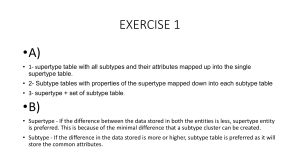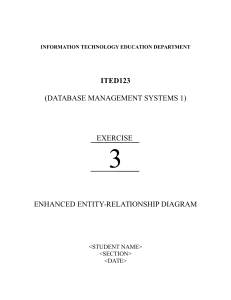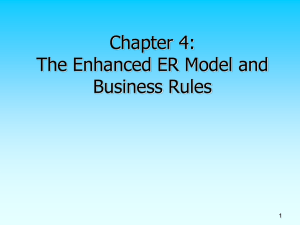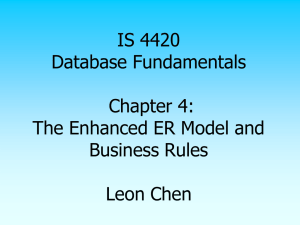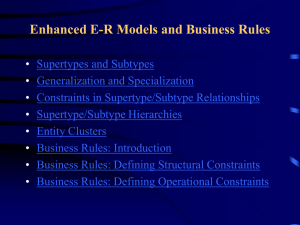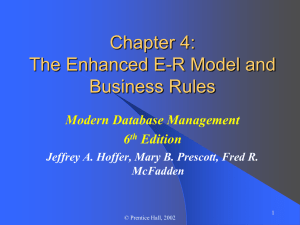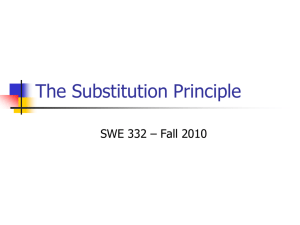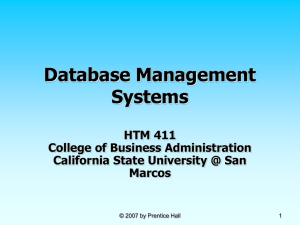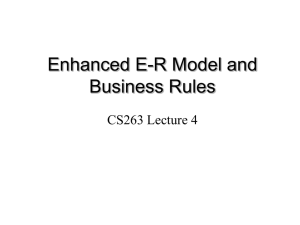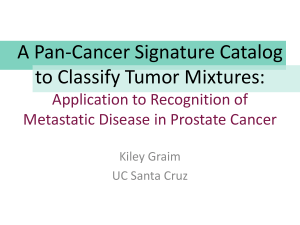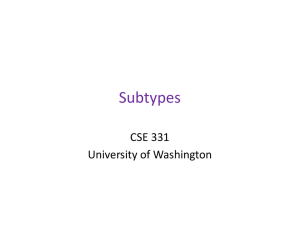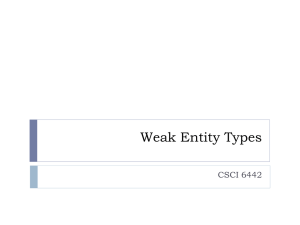The Enhanced ER Model and Business Rules
advertisement
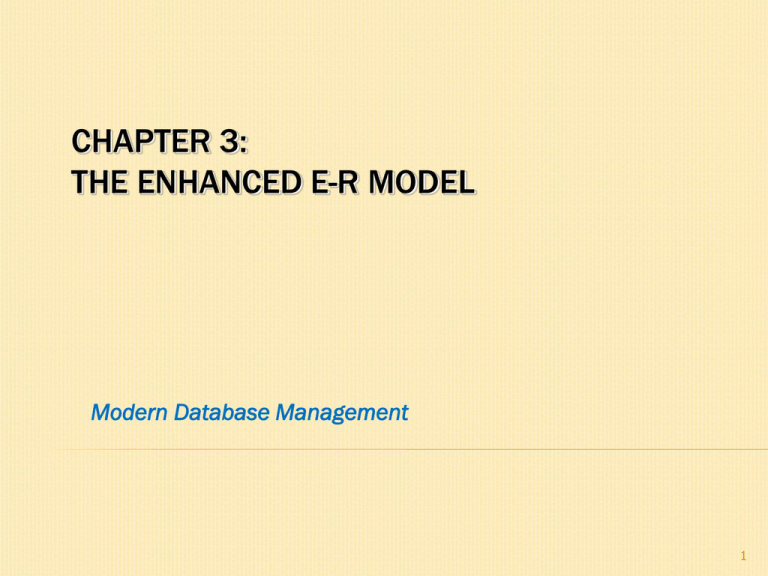
CHAPTER 3: THE ENHANCED E-R MODEL Modern Database Management 1 OBJECTIVES Define terms Understand use of supertype/subtype relationships Understand use of specialization and generalization techniques Specify completeness and disjointness constraints Develop supertype/subtype hierarchies for realistic business situations Develop entity clusters Explain universal (packaged) data model Describe special features of data modeling project using packaged data model 2 SUPERTYPES AND SUBTYPES Enhanced ER model: extends original ER model with new modeling constructs Subtype: A subgrouping of the entities in an entity type that has attributes distinct from those in other subgroupings Supertype: A generic entity type that has a relationship with one or more subtypes Attribute Inheritance: Subtype entities inherit values of all attributes of the supertype An instance of a subtype is also an instance of the supertype 3 Figure 3-1 Basic notation for supertype/subtype notation a) EER notation 4 Figure 3-1 Basic notation for supertype/subtype notation (cont.) b) Microsoft Visio Notation Different modeling tools may have different notation for the same modeling constructs. 5 Figure 3-2 Employee supertype with three subtypes All employee subtypes will have employee number, name, address, and date hired Each employee subtype will also have its own attributes 6 RELATIONSHIPS AND SUBTYPES Relationships at the supertype level indicate that all subtypes will participate in the relationship The instances of a subtype may participate in a relationship unique to that subtype. In this situation, the relationship is shown at the subtype level 7 Figure 3-3 Supertype/subtype relationships in a hospital 8 GENERALIZATION AND SPECIALIZATION Generalization: The process of defining a more general entity type from a set of more specialized entity types. BOTTOM-UP Specialization: The process of defining one or more subtypes of the supertype and forming supertype/subtype relationships. TOP-DOWN 9 Figure 3-4 Example of generalization a) Three entity types: CAR, TRUCK, and MOTORCYCLE All these types of vehicles have common attributes 10 Figure 3-4 Example of generalization (cont.) b) Generalization to VEHICLE supertype So we put the shared attributes in a supertype Note: no subtype for motorcycle, since it has no unique attributes 11 Figure 3-5 Example of specialization a) Entity type PART Only applies to manufactured parts Applies only to purchased parts 12 Figure 3-5 Example of specialization (cont.) b) Specialization to MANUFACTURED PART and PURCHASED PART Created 2 subtypes Note: multivalued composite attribute was replaced by an associative entity relationship to another entity 13 CONSTRAINTS IN SUPERTYPE/SUBTYPE RELATIONSHIPS Completeness Constraints: Whether an instance of a supertype must also be a member of at least one subtype Total Specialization Rule: Yes (double line) Partial Specialization Rule: No (single line) 14 Figure 3-6 Examples of completeness constraints a) Total specialization rule 15 Figure 3-6 Examples of completeness constraints (cont.) b) Partial specialization rule 16 CONSTRAINTS IN SUPERTYPE/SUBTYPE RELATIONSHIPS Disjointness Constraints: Whether an instance of a supertype may simultaneously be a member of two (or more) subtypes Disjoint Rule: An instance of the supertype can be only ONE of the subtypes Overlap Rule: An instance of the supertype could be more than one of the subtypes 17 Figure 3-7 Examples of disjointness constraints a) Disjoint rule 18 Figure 3-7 Examples of disjointness constraints (cont.) b) Overlap rule 19 CONSTRAINTS IN SUPERTYPE/SUBTYPE RELATIONSHIPS Subtype Discriminator: An attribute of the supertype whose values determine the target subtype(s) Disjoint – a simple attribute with alternative values to indicate the possible subtypes Overlapping – a composite attribute whose subparts pertain to different subtypes. Each subpart contains a Boolean value to indicate whether or not the instance belongs to the associated subtype 20 Figure 3-8 Introducing a subtype discriminator (disjoint rule) 21 Figure 3-9 Subtype discriminator (overlap rule) 22 Figure 3-10 Example of supertype/subtype hierarchy 23 ENTITY CLUSTERS EER diagrams are difficult to read when there are too many entities and relationships. Solution: Group entities and relationships into entity clusters. Entity cluster: Set of one or more entity types and associated relationships grouped into a single abstract entity type 24 Figure 3-13a Possible entity clusters for Pine Valley Furniture in Microsoft Visio Related groups of entities could become clusters 25 Figure 3-13b EER diagram of PVF entity clusters More readable, isn’t it? 26 Figure 3-14 Manufacturing entity cluster Detail for a single cluster 27 PACKAGED DATA MODELS Predefined data models Could be universal or industry-specific Universal data model = a generic or template data model that can be reused as a starting point for a data modeling project (also called a “pattern”) 28 ADVANTAGES OF PACKAGED DATA MODELS Use proven model components Save time and cost Less likelihood of data model errors Easier to evolve and modify over time Aid in requirements determination Easier to read Supertype/subtype hierarchies promote reuse Many-to-many relationships enhance model flexibility Vendor-supplied data model fosters integration with vendor’s applications Universal models support inter-organizational systems 29 Figure 3-15 PARTY, PARTY ROLE, and ROLE TYPE in a universal data model (a) Basic PARTY universal data model Packaged data models are generic models that can be customized for a particular organization’s business rules. 30 Figure 3-15 PARTY, PARTY ROLE, and ROLE TYPE in a universal data model (b) PARTY supertype/subtype hierarchy 31
